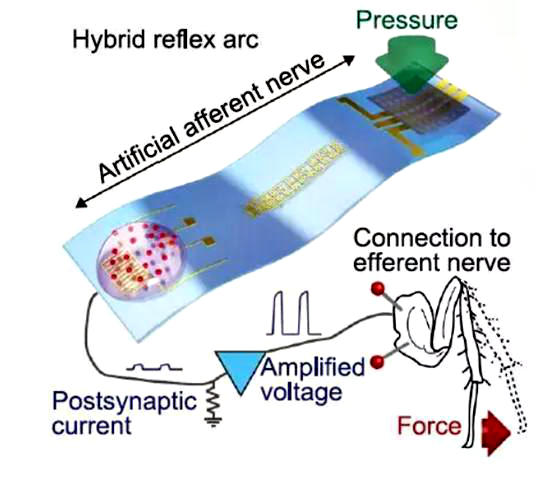


Electronic skin is an electronic device created using flexible electronics, designed to mimic the properties of human skin. Beyond just replicating the skin’s softness, it is crucial for electronic skin to possess tactile sensing capabilities. It can not only simulate the functions of human skin but also surpass them, helping humans acquire physical and chemical signals from the environment and the body, thus enhancing interaction with the surroundings or oneself.
As the largest organ of the human body, the skin is the main carrier of touch perception. Our ability to sense an object’s hardness comes from pressure receptors in the skin that can distinguish the softness or hardness of objects based on the magnitude of the applied force. Electronic skin can replicate this function through pressure sensors. The most basic and commonly used method for this is the piezoresistive pressure sensor, which uses conductive materials that change resistance when deformed to achieve sensing.
Flexible pressure sensors can detect not only pressure but also the shape of objects. Researchers at MIT have designed a low-cost stretchable tactile glove embedded with 548 piezoresistive pressure sensors. These sensors can record pressure values in detail for each sensing point. Using this data, they trained a deep learning network to identify different objects.
By integrating flexible electronics with stretchable sensors, temperature sensors, and more, electronic skin with tactile functions can be developed. The most direct application of electronic skin is in intelligent robots. Robots equipped with tactile sensing can more precisely read pressure signals from their environment, allowing for more accurate, diverse, and effective actions. For instance, current robots face difficulties in grasping and manipulating small and soft objects. The detailed mechanical feedback provided by electronic skin can help overcome these challenges.
Although sensor-level object perception is achievable, effectively converting sensor signals into neural electrical signals that the brain can understand remains a challenge. Through biomimetic technologies, scientists have invented artificial afferent nerves. These artificial nerves include piezoresistive pressure sensors, organic ring oscillators, and synaptic transistors. The pressure sensor collects pressure data, the oscillator converts it into voltage pulses, and the synaptic transistor integrates these pulses into postsynaptic current, interfacing with biological efferent nerves to form a complete monosynaptic reflex arc.
Scientists connected artificial afferent nerves to the efferent nerves of cockroach legs. By applying pressure through the pressure sensor, they successfully triggered movement in the cockroach legs. This experiment demonstrates the potential of artificial nerves in biological applications. Furthermore, with brain-machine interface technology, specific areas and cells of the brain can be stimulated using encoded signals to create a tactile experience. Although our understanding of neural coding for perception is still limited, and significant breakthroughs are needed in brain-machine interface technology, this presents a possible pathway for future tactile signal conversion.

Other Applications of Flexible Electronics
Beyond building tactile systems, flexible electronics can endow various sensors with skin-like properties such as softness, stretchability, and self-healing. These sensors can be worn on the skin or embedded in clothing to continuously sense environmental and bodily information. Moreover, electronic skin can detect UV intensity, humidity, magnetic fields, proximity of objects, and even monitor physiological indicators such as blood glucose levels non-invasively, as well as collect brain waves, muscle activity, and ECG signals. These applications highlight the vast potential of flexible electronics across numerous fields.